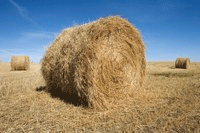
 While producers may find it challenging to get hay dry in early June due to changing weather conditions, there are steps producers can take to get hay up quickly and reduce the potential for rain damage, said a forage expert with Ohio State University's College of Food, Agricultural, and Environmental Sciences.
While producers may find it challenging to get hay dry in early June due to changing weather conditions, there are steps producers can take to get hay up quickly and reduce the potential for rain damage, said a forage expert with Ohio State University's College of Food, Agricultural, and Environmental Sciences. "Proper tedding, raking, and equipment care are just some of the steps producers can take to reduce drying time and produce high-quality hay, said Clif Little, an educator with the college's outreach arm, Ohio State University Extension.
Although drying time for hay is impacted by forage species, environmental conditions, cut height, conditions and swath width, a good management plan can make a big difference in hay quality, he said.
"Cutting and drying hay quickly is always important, especially with everything being a little behind this year because of the planting season," Little said. "Feed prices are high, so anything producers can do to produce quality hay is a benefit.
"We're fighting rain as well as other work we've got to do around the farm. But we still have to get hay up quickly because when we get rain on our forage it can be devastated or ruined. So using these steps may allow producers to get it up a day or two earlier."
The tips include:
- Make sure hay mowing equipment rollers are adjusted properly.
- Cutting hay in the morning after the dew is off can help speed drying time and reduce the loss of carbohydrates due to respiration. Respiration is a natural process and continues until the plant dries to a moisture content of approximately 40 percent.
- The swath width can influence hay drying time as well. High-yielding forages should be laid in a wide swath, which will give better access to sun and wind.
- Tedding is often utilized to reduce drying time by spreading the hay. While tedding increases costs in terms of time and fuel, this increase is offset by a reduction in drying time.
- Tedding hay shortly after cutting and when it contains no less than 50 percent moisture will reduce leaf shatter and forage loss.
- Raking hay at the improper moisture content may contribute to loss of plant leaf material.
- The best moisture content for raking is 30-40 percent. Raking when the hay is ready to bale (very dry) can cause major leaf shatter and reduce the overall nutrient content of the forage.
- Bailing at the proper moisture content based on the size and shape of bales can also reduce harvest and storage loss. For most small rectangular and large round bales, the recommended bailing moisture content is 18 percent. For high-density large rectangular bales, the range can be 12-14 percent moisture for proper storage.
- If storing hay outside, make sure you choose a location that is dry, preferably on a solid surface like rock, and make sure the location is high and open to wind.
Return to Industry Buzz.
6.17.2013